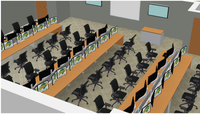Spotlight on Economics: Commodity and Financial Trading Lab
(Click an image below to view a high-resolution image that can be downloaded)
By William W Wilson, University Distinguished Professor
NDSU Agribusiness and Applied Economics Department
The Agribusiness and Applied Economics Department is developing a commodity trading room (CTR) for Barry Hall. All is in order for the installation of equipment during June and be operational in our curriculum beginning with the 2012 fall semester.
Developing a CTR is in response to the growth in commodities trading and importance of commodity trading to North Dakota, which includes trading in agricultural, energy and transportation products.
NDSU has a strong history of training and placing students in agricultural trading positions. However, there is demand for more advanced training because of the rapid growth in technology (information, analytics and software).
There also is demand for more sophisticated training for industry, commodity firms and organizations.
The purpose of the CTR is to provide a dedicated room to teach commodity marketing, logistics, trading and risk management. The output will be more and better trained students that will work in the different segments of these industries.
The CTR will be a high-technology room with live information feeds for financial information, including equities, credit, forrex and more, plus commodity market information, such as agriculture, energy and biofuels.
Students will have the ability to analyze portfolios, trading strategies and risks. All of these are important in North Dakota and the region. Most competing business schools have financial and trading rooms. Developing a trading room in Barry Hall will provide similar training and research opportunities for NDSU students and faculty. For the agribusiness industry, NDSU will be the first school having such capabilities that focuses on agriculture and the biofuels sector.
Agribusiness employers have encouraged the development of the trading room for several reasons:
- Increasing enrollment among students wanting to pursue careers in commodity trading.
- Enhanced educational opportunities by providing a state-of-the-art teaching platform.
- Escalating the sophistication of training for students.
These firms already have made varying forms of commitment to support the operations of the room. In addition, there are substantial opportunities for research and outreach in numerous forms with the use of this technology.
The CTR should be viewed as a laboratory for analyzing markets and financial instruments. This is no different than a laboratory for biology or chemistry. Typically, research assignments are given and pursued separately. During a class period, the assignments are illustrated and reviewed. In many cases, the results are used for conducting trade simulations.
The project will develop a high-technology room that can be used to analyze markets in real-time and illustrate trade simulations. The CTR will be modeled after a similar project at Tulane University. Technically, the room will have 32 work stations. Sixteen of the works stations will have access to live commodity and financial market information for agriculture, commodities and financials. The number of live stations will be expanded in the future.
The CRT will include simulation software from Trading Technologies, which will allow us to teach electronic trading (prevailing mode of trading). We also will be able to discuss market depth, with the capabilities of conducting live and replay simulations in any of these markets. For example, we will be able to simulate market behavior for specific days, in high-speed, for illustration.
There are several information providers that will be used, including Bloomberg, DTN and Thomson-Reuters-EIKON. Thomson-Reuters is used at Tulane. Bloomberg is more common in the financial industries, while DTN is more common in the commodities, energy and biofuels markets. We are evaluating these information providers and receiving bids.
The CTR will be used for teaching courses in agribusiness and the College of Business. Opportunities also will be explored through the Tri-College system. There are plans for numerous outreach programs for individual firms, commodity organizations, Northern Crops Institute, biofuels sector and fee-based advanced programs (to be developed).
This is a fairly costly venture. Funding has been provided by the North Dakota Agricultural Experiment Station, Vice President of Academic Affairs and NDSU Technology Fee Advisory Committee. The funds are seed money for computers and other hardware.
The project has been encouraged by some major agribusiness firms who have provided varying forms of financial support. These include ADM, CHS, Gavilon, The Rice Trader and George M Schuler III of Minn-Kota Ag Products Inc. A number of state commodity organizations have provided funding, including the North Dakota Corn Council, North Dakota Soybean Council, North Dakota Wheat Commission and Northern Crops Institute. A number of other agribusiness firms and entities have expressed interest in a sponsorship. These will be pursued in the coming months.
In addition, the NDSU Development Foundation is working toward establishing an endowment for the permanent support of the CTR.
NDSU Agriculture Communication – Feb. 29, 2012
| Source: | Bill Wilson, (701) 231-7472, william.wilson@ndsu.edu |
|---|---|
| Editor: | Rich Mattern, (701) 231-6136, richard.mattern@ndsu.edu |



